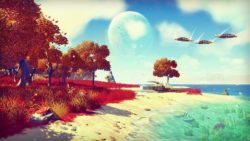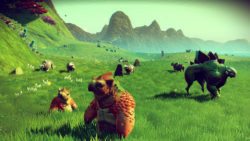No Man’s Sky Review
18 quintillion planets. Limitless alien creatures to populate them. A crazy amount of ships, and the promise of the adventure of a lifetime. That’s a bold claim, but did No Man’s Sky live up to the hype?
One thing’s for sure; No Man’s Sky is certainly a big game. From the get-go, you’re thrown onto a giant (almost certainly planet-sized) world that is the product of procedural generation with the task of repairing your ship so that you may leave and discover even more planets. The planets in this game can be quite literally worlds apart – variations in toxicity, radiation, temperature, atmosphere and mineral composition are all factored into the code, creating a broad range of diversity. During my journey, I’ve found completely submerged aquatic havens, extremely toxic plains that are a victim of severe acid rain, burning red planets and grey, dead wastelands.
Slightly more intriguing is the life placed onto each planet. Each world can be dense, with a multitude of lush plant life or infested with just a single specimen, the fauna present having their diets fixed accordingly. The animals in question are just as varied as the planets, ranging from carnivorous bipedal dinosaurs to large mushroom-like entities and literal flying fish. The player is encouraged to discover each and every life-form present on a given planet, with the ability to scan and name everything you find.
Exploration is built upon through the use of survival mechanics: your suit has life-support and hazard protection mechanisms that require recharging. Each planet has minerals that you can use to repair and upgrade your suit through crafting, somewhat reminding me of Minecraft. These minerals can also be stocked and sold for profit at a trading interface, found at some sites inhabited by intelligent life such as at trade outposts on planets and space stations in space. However, these minerals must be stored in an inventory that is initially minuscule; although the amount of inventory space increases by a fair amount once your suit/ship has been upgraded.
I frequently found that the worst part of exploring was just how slow the playable character moves – oftentimes the usual pace of motion is a fairly slow walk, with the other options consisting of a quick-depleting sprint or a jetpack that seems to leak fuel. There is no way to warp to your ship, and so I often found myself moving my ship around the world to visit any of the points of interest at the cost of valuable launch thruster fuel.
When you’re not traversing a planet you will probably be found somewhere in space, travelling to your next world or mining asteroids. Space travel itself is a fairly fun experience, with the ships you own controlling smoothly and capable of sustaining several upgrades. Occasionally, you may run into trouble with space pirates which will attempt to destroy your ship, but these can often be notoriously difficult to fight without the correct upgrades. In these situations, replacing your ship can help – you can buy ships from aliens present at outposts or stations, but this can quickly become a very expensive habit.
Sentient life in No Man’s Sky takes form through the four races present in the game. You can interact with these species at a space station (rather suspiciously containing only one race per station) or in an inhabited building on a planet. At first, communication with these races will be difficult, thanks to each race having its own language. Words can be learnt through simple interactions or by reading one of the monoliths or language stones present on a planet – while I found the concept intriguing, learning one of these dialects can be a very slow process as usually only one word is discovered at a time.
No Man’s Sky’s largest flaw is perhaps its very concept – nothing is ever truly infinite. I occasionally stumbled across animals that looked all-too familiar and planets that were simply identical. Sites of interest on planets are also repeated – abandoned buildings and outposts will always take the same form. That said, No Man’s Sky does offer up many exhilarating moments, such as when I finally left my first planet, my first (albeit painful) encounter with a ravenous carnivore, that feeling of power when I purchased a much larger ship, and the rush of energy I got when I defeated a large group of space raiders. In addition, the game opens up considerably once you progress past the early parts of the game – planets become more varied and unique features begin to appear in space. I’m sure that this game will improve further over time, given the rigorous update schedule that is destined to appear in the near future, but for now it’s not quite the adventure of a lifetime we were promised.



Comments